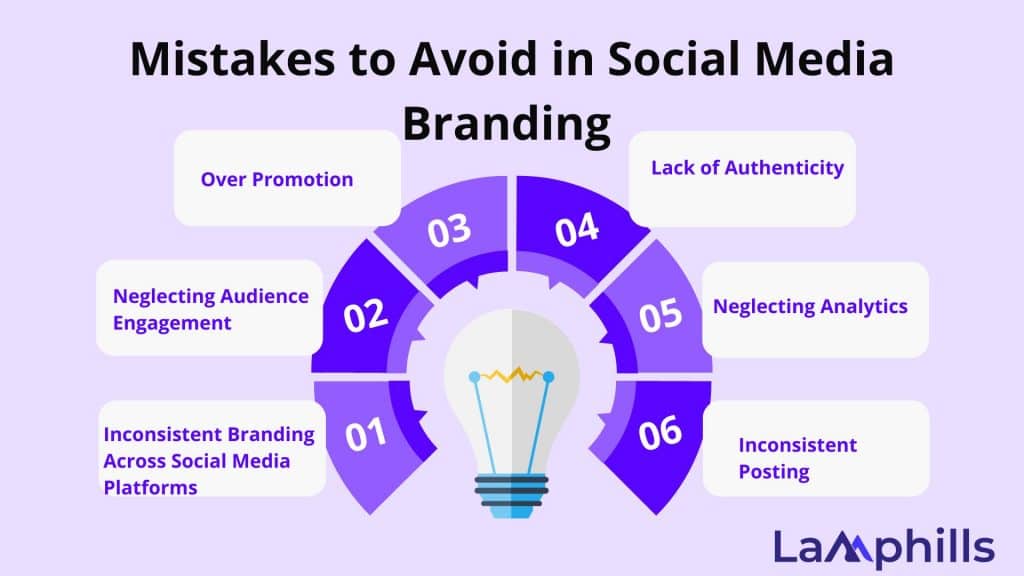With over 63.7% of the world’s population on social media, most businesses presently use these platforms for branding strategies, knowing it’s not just for interaction. Brands now build their identity, attract loyal followers, and convert casual viewers into lifetime customers. Your online presence can be the deciding factor between whether someone chooses your brand or your competitor’s. Studies show that 90% of people buy from brands they follow on social media. This brings us to the question, “How can businesses create a brand identity that cuts through the noise and resonates with their audience?
I started as a social media manager before going into digital marketing, and I understand the importance of social media branding for businesses. This guide answers the above question and will help you master social media branding. It also includes practical tips that ensure your brand stands out and builds lasting connections with your followers based on research and personal experience.
Key Points
- Social media branding strategically uses content, visuals, and engagement to shape how people perceive your brand online. It’s the digital face of your company, and getting it right can be the key to long-term success.
- Strong online branding differentiates you, influences purchasing decisions, builds trust, and fosters brand loyalty.
- Measuring the success of your social media branding isn’t just about looking at follower counts or likes—it’s about understanding how your branding efforts contribute to your overall business goals.
- The best ways to build your SM brand are to understand your audience, have a compelling voice, maintain visual consistency, and engage authentically.
What Is Branding in Social Media?
Social media branding strategically uses content, visuals, and engagement to shape how people perceive your brand online. It’s the digital face of your company, and getting it right can be the key to long-term success. As Amazon’s Jeff Bezos once said, “Your brand is what people say about you when you’re not in the room.” This couldn’t be more relevant online, where impressions and opinions form quickly.
Famous entrepreneur Gary Vaynerchuk once said, “Your brand is your reputation. And your reputation in perpetuity is the foundation of your career.” This insight is key when building a social media brand—your online identity is not just a one-off effort; it’s an ongoing conversation with your audience.
Social Media Branding: Why Should You Care?
According to a Sprout Social report, 86% of consumers prefer authentic and honest brand personas on social media, and more than half would unfollow a brand if its content is irrelevant. I’ve unfollowed a brand because of this. So why should you care or be intentional about your social media branding? Let’s just say your brand is the digital handshake that invites your audience to connect with you and, in many cases, make a purchase. In other words, strong branding differentiates you, influences purchasing decisions, and builds trust. It also fosters brand loyalty.
Why is Social Media Branding Good?
Social media branding is good for several reasons. First, it significantly allows brands to tailor their content to specific audience segments, which fosters deeper connections and enhances engagement. Secondly, it increases brand awareness, builds trust and credibility, promotes better customer engagement, and provides valuable insights into customer behavior, preferences, and feedback. Lastly, it provides an effective platform for crisis management and reputation control. This allows businesses to respond swiftly to issues or negative publicity to maintain a positive brand image.
Social Media Branding Kit
A social media branding kit is a toolbox that contains everything a brand needs to ensure uniformity and consistency in its online presence. It includes logos, color schemes, fonts, imagery, and guidelines for representing the brand across different social platforms.
Elements of a Social Media Branding Kit
The following are the core elements that make up a strong social media branding kit:
- Logos
- Color Palette
- Typography
- Templates
- Brand Tone and Voice
- Hashtags and Keywords
How to Create a Social Media Branding Kit
Creating a social media branding kit requires strategic thinking and an in-depth understanding of the brand’s core values, audience, and platform preferences. Below are the steps I usually follow when working with clients to build a kit:
- Define Your Brand Identity
- Design Logos and Choose Colors
- Select Fonts
- Create Templates
- Establish Brand Voice Guidelines
Tools for Building Your Social Media Branding Kit
Several tools are available to help you create a social media branding kit without needing advanced design skills. The following are some of these tools:
- Canva
- Adobe Creative Cloud.
- Tailwind
- Brandfolder
Read Also: The Best Media Planning Tools for Advertisers and Brands
Social Media Branding Strategy
The following are the top strategies I adopt for social media branding:
#1. Define Your Brand Identity: The Foundation of Social Media Branding
From my experience, the first step to successful social media branding is a crystal-clear brand identity. Before considering which platforms to use, I always ask, “What does this brand stand for?” Your brand’s identity must be built on your mission, vision, and core values. This identity will inform everything—from your voice and tone to your visuals and overall content strategy. In my experience working with startups, a clear brand identity has often been the key differentiator in crowded markets. For instance, the Coca-Cola brand identity revolves around happiness and positivity, something they consistently communicate across all platforms.
Below is how I define a brand’s identity:
- Mission and Vision: Mission and vision are two different things that define your brand‘s purpose and its long-term goals. For example, Nike’s mission to “bring inspiration and innovation to every athlete” is a guiding light for all their content.
- Core Values: What principles define your brand? Authenticity, innovation, and sustainability are examples that resonate with audiences.
- Brand Personality: Is your brand casual or formal? Professional or playful? Consistency in how your brand communicates is essential.
#2. Know Your Audience Inside and Out
Knowing your audience in detail helps you tailor your brand’s voice, messaging, and content to connect on a deeper, more personal level. Successful brands speak directly to their audience’s needs, desires, and interests. But to do that, you first need to understand who they are. Who is your ideal follower? What content do they engage with? Where do they spend the most time online? Your product or service can also point these out, but below is how I help businesses identify their target audience.
Start by:
- Diving into Demographics: Use tools like Facebook Insights or Instagram Analytics to find out where your audience is from, their age range, and their interests.
- Listening to Conversations: Social listening tools like Hootsuite and Mention allow you to track online conversations about your industry, competitors, or brand.
- Creating Detailed Personas: Build audience personas that capture key demographics and behaviors. Consider their values, challenges, and social media habits.
#3. Establish a Voice That Resonates
Your brand’s voice is the heart and soul of your messaging. It should be consistent, clear, and reflect your values. A well-defined brand voice ensures your followers know what to expect and builds trust over time. So, are you fun and quirky like Wendy’s on Twitter? Or professional and inspiring like LinkedIn? Brands that have a consistent voice are more memorable and relatable. Jay Baer, a social media guru, once said, “Make your marketing so useful people would pay you for it.” This is a reminder to keep your content valuable, not just promotional.
The following are detailed guides on how I establish a voice that resonates:
- Define Key Traits: Is your brand formal, casual, or humorous? Establish these traits early on.
- Create a Brand Voice Chart: List dos and don’ts for your social media tone to maintain uniformity across platforms.
- Engage Authentically: Whether it’s responding to comments or jumping into trending topics, stay true to your brand’s personality. Authenticity wins over pretense.
#4. Visual Consistency: The Power of Imagery
One of the easiest ways to build a recognizable brand on social media is through visuals. Your visuals are the first thing your audience sees—and they form instant impressions. In fact, consistent visual branding across social platforms can increase revenue by up to 33%. Every visual element should reinforce your brand identity, from your logo to your color scheme and fonts. Visual consistency builds brand recognition. The more familiar your content looks, the easier it is for your audience to connect with you.
For example, when I worked on branding for a retail brand, we emphasized a bold color palette to stand out in a saturated market. Our visuals became instantly recognizable across platforms, driving engagement and brand loyalty.
Look at Nike—whether on Instagram or YouTube, the black-and-white contrast, bold typography, and motivational imagery contribute to their strong brand identity. This consistency across platforms is what makes them recognizable and trustworthy.
How to Nail Your Visual Branding:
- Create Brand Guidelines: A style guide that outlines your color palette, logo usage, fonts, and image style will ensure consistency.
- Use Design Tools: Platforms like Canva or Adobe Spark make it easy for non-designers to create branded content.
- Maintain Uniformity: Your profile pictures, banners, and post formats should align across platforms to reinforce your brand.
- Fonts: Choose typography that reflects your brand’s tone. A luxury brand, for instance, might opt for sleek, modern fonts.
- Imagery Style: Whether you use photography, illustrations, or animations, your visuals should be cohesive and distinct.
#5. Content That Speaks Volumes: Tailor Your Messaging
Content is at the heart of any social media branding strategy; therefore, create content that reflects your brand and audience’s needs. Over the years, I’ve seen that the most successful brands find a balance between educational, entertaining, and inspirational content.
Below are some of the effective content types I adopt:
- Educational Content: Share useful tips, guides, and insights to position your brand as an industry expert.
- Entertainment: Leverage fun, engaging content like quizzes, behind-the-scenes videos, or challenges. According to HubSpot, visual content is 40 times more likely to get shared on social media than other types.
- Inspiration: Tell stories that reflect your brand’s values or highlight customer success stories.
#6. Adapt Content to the Platform: Speak the Language of Each Social Channel
Each social media platform has a unique audience and opportunities; even competitive ones still have distinct features. What works on Instagram might not resonate on LinkedIn. Therefore, tailor your branding strategies to fit each platform. Aligning your branding efforts to each platform’s strengths increases your chances of connecting with the right audience. For instance:
- Instagram: This is ideal for brands that thrive on visuals. Use a mix of feed posts, Stories, and Reels to engage your audience and showcase your products. Brands like GoPro use visually stunning content to inspire their followers.
- Facebook: The platform for building communities. Create dedicated groups, run targeted ads, and post engaging long-form content for deeper connections.
- LinkedIn: Best for professional branding. Share thought leadership content and engage with industry experts to position your brand as a leader.
- TikTok: For short, viral content. The platform’s playful nature offers a great way to humanize your brand like Chipotle does with its humorous and fun videos.
#7. The Power of Storytelling in Branding
Storytelling sets brands apart because people connect with stories—not just products or services. To effectively build your brand on social media, you need to tell the story of who you are, why you exist, and what you stand for. Besides, stories are memorable; they create emotional bonds that make people want to follow, support, and buy from you.
Think of Nike’s “Just Do It” campaign. It wasn’t just about selling shoes; it was about empowering people to push their limits. This is what brand storytelling does—it inspires your audience to connect with you on a deeper level.
How to Weave Stories Into Your Branding:
- Customer Stories: Share testimonials or case studies highlighting how your product impacts lives.
- Behind-the-Scenes Content: Give your audience a glimpse of what goes on in your business. It humanizes your brand and builds trust.
- Mission and Values: Share your brand’s purpose and make your audience part of your journey.
#8. Leverage Partnerships and Influencers
I’ve worked with several brands that have seen exponential growth by partnering with influencers. Sincerely, influencer marketing can help brands reach new audiences, build credibility, and drive conversions.
According to Statista, 93% of marketers use influencer marketing in some capacity. However, the key is choosing influencers whose values align with your brand.
#9. Build Genuine Engagement
Social media isn’t just about broadcasting your message—it’s a two-way street. Your audience wants to interact with you, not just passively consume your content. Brands that engage consistently build stronger relationships and foster loyalty. Starbucks, for instance, frequently reposts photos of customers enjoying their coffee—showing they value their community’s input.
Use the tips below to boost your engagement:
- Respond to Comments: Acknowledge your audience when they engage with you.
- Ask Questions: Start conversations by asking open-ended questions. Polls, Q&As, and surveys are great ways to involve your audience.
- Leverage User-Generated Content: Encourage your followers to share their experiences with your brand. Repost their content to build community and trust.
#10. Consistency is Key: Establish a Posting Schedule
Brands that maintain a steady posting rhythm always stay top-of-mind for their audience. Regular posting is essential for maintaining visibility and engagement. I’ve seen brands grow exponentially by adhering to a consistent posting schedule.
Below are some of the tips I adopt for consistency:
- Content Calendar: Plan content ahead of time and stick to a posting schedule.
- Peak Posting Times: Use analytics to determine the best times to post for maximum engagement.
#11. Measure, Adjust, and Optimize
Social media branding is an ongoing process; therefore, track and analyze your efforts often. Monitor engagement rates, impressions, follower growth, and conversions to gauge the success of your branding. Reviewing your data will help you adjust your strategies to keep your brand relevant and impactful.
Below are some of the tools I use for tracking my efforts:
- Google Analytics: Track website traffic from social media.
- Hootsuite: Monitor engagement and social reach.
- Buffer: Analyze which posts drive the most interaction and conversions.
Read Also: A Comprehensive Guide to the Best Social Media Aggregators in 2024
Mistakes to Avoid in Social Media Branding

While crafting social media strategies for multiple brands, I’ve seen what works—and more importantly, what doesn’t. Several brands fall into common traps that can completely derail their efforts. As much as you can, avoid the following mistakes in your social media branding strategies:
#1. Inconsistent Branding Across Platforms
One of the most detrimental mistakes I see is inconsistent branding. Brands often fail to maintain the same visual and verbal identity across platforms, leading to confusion. When a brand looks different on Instagram, Facebook, or LinkedIn, it diminishes its overall credibility.
Consistency is key in establishing a strong brand identity,” says branding expert Marty Neumeier. According to Lucidpress, consistent branding can increase revenue by up to 23%. So, create a cohesive brand style guide that dictates logo usage, colors, fonts, and tone across all platforms. This ensures a unified look and also strengthens your brand’s recall.
#2. Neglecting Audience Engagement
You can’t just “post and ghost.” Social media is a two-way street, and if you’re not engaging with your audience, you’re losing out on one of the biggest advantages of these platforms—direct communication. Many brands push out content but fail to engage with their audience’s comments or direct messages.
So, make time to respond to comments, questions, and even criticisms. Active engagement fosters stronger relationships and leads to greater brand loyalty.
#3. Over-Promotion
Too often, brands make the mistake of turning their social media pages into non-stop sales pitches. While your ultimate goal may be to sell, your audience is looking for value beyond just products or services.
Follow the 80/20 rule—80% of your content should educate, entertain, or provide value, while only 20% should be promotional. This helps build trust and keeps your audience from tuning out. According to a HubSpot report, 54% of consumers prefer video content from brands that entertain or educate rather than promote directly.
#4. Lack of Authenticity
Trying to copy competitors or appeal to everyone dilutes your brand’s authenticity. Remember, people connect with genuine stories and personalities. Be true to your brand’s values and let that shine through in your messaging. Don’t be afraid to show behind-the-scenes content, celebrate your team’s victories, or share customer stories. Authenticity leads to trust, and trust leads to sales. A Stackla study found that 90% of consumers say authenticity is important when deciding which brands they like and support.
#5. Neglecting Analytics
Ignoring data is like driving without a map. Without tracking your performance, you won’t know what’s working and what isn’t. I often see brands not leveraging analytics tools, which is missed opportunity for growth. So, regularly review your performance metrics, such as engagement rates, reach, and follower growth. Social platforms provide these insights for free—use them! According to a Gartner study, brands that adopt data-driven strategies improve their marketing ROI by 15-20%.
#6. Inconsistent Posting
One of the more subtle mistakes is inconsistent posting—either too much or too little. If you overwhelm your audience with constant posts, you risk driving them away. On the flip side, long gaps between posts can make your audience forget you exist. So, develop a content calendar and stick to a consistent schedule. Tools like Hootsuite or Buffer can help you plan posts in advance to maintain a steady stream of content.
Lamphills Daily Social Media Branding Checklist
This Lamphills social media branding checklist is designed to help individuals and businesses create and maintain a consistent, impactful presence on social media. It ensures that your brand’s voice, visuals, and messaging are aligned across all platforms, helping to build trust and recognition with your audience.
Download Lamphill Daily SM Branding Checklist
How to Measure the Success of Social Media Branding
Measuring the success of your social media branding isn’t just about looking at follower counts or likes—it’s about understanding how your branding efforts contribute to your overall business goals. Below is how I evaluate the success of my social media branding:
#1. Brand Awareness
The first step in measuring branding success is to gauge how well people recognize your brand. This goes beyond follower counts and looks at the reach and visibility of your content. So, track impressions (how many times your content is seen) and reach (how many unique users have seen your content). Tools like Google Analytics and Facebook Insights are great for this.
#2. Engagement Rate
While followers matter, engagement is a far better indicator of your social media success. Are people interacting with your posts? Are they sharing, commenting, or liking?
The engagement rate can be calculated by dividing the number of interactions (likes, comments, and shares) by your total followers, and then multiplying by 100. Aim for an engagement rate of 1-5%, which is considered good in most industries. A Rival IQ study found that the average engagement rate across all industries is around 0.6% on Instagram, 0.09% on Facebook, and 0.048% on Twitter.
#3. Follower Growth
Follower growth is a good indicator of whether your content is attracting attention. However, focus on the quality of followers, not just the quantity. Are you gaining followers that align with your target audience? According to Statista, 74% of marketers say increasing audience quality is more important than audience size. Track follower growth monthly, and pay attention to the demographics of your new followers.
#4. Website Traffic and Conversions
If one of your goals is to drive traffic to your website, track how many visitors are coming from social media. You also want to measure what those visitors do once they land on your site—whether they sign up for newsletters, fill out forms, or make purchases.
You can use UTM codes to track social media links. This helps you see exactly how much traffic comes from each platform. You can also track traffic sources, bounce rates, and conversions with Google Analytics.
#5. Audience Sentiment
Your audience’s feelings toward your brand can make or break your success. Positive sentiment indicates a loyal audience. On the other hand, negative sentiment might mean you need to re-evaluate your messaging. Tools like Brandwatch or Awario can help you analyze the tone of the comments and mentions you receive. Sentiment analysis helps you see if people are talking positively or negatively about your brand.
#6. Share of Voice (SOV)
Share of voice measures how much of the conversation around your industry or niche is focused on your brand compared to competitors. It’s a powerful metric for understanding how well you stand out. Tools like Sprinklr or Hootsuite help you track this. You should aim to increase your share of voice over time to establish your brand as a leader in your industry. Forrester Research found that brands with a higher share of voice tend to have a higher market share.
#7. Customer Retention and Loyalty
Finally, it’s not just about gaining new customers but also retaining the ones you have. Repeat engagement and loyal followers show that your brand has established a lasting connection with its audience. Measure customer retention and loyalty through engagement from repeat users. If people return to your social media profiles or engage multiple times, it’s a sign that your branding resonates with them. Harvard Business Review highlights that increasing customer retention by just 5% can boost profits by 25% to 95%.
Conclusion
Ready to build a brand that resonates and lasts? Start with these tips and watch your social media presence transform from ordinary to unforgettable. Although time, strategy, and consistent effort are required in building a powerful social media brand, you can cross the hurdles by understanding your audience, crafting a compelling voice, maintaining visual consistency, and engaging authentically. You too can create a brand that doesn’t just exist online but thrives. Best of luck!
Related Articles
- Purpose of Branding: 10 Benefits for Your Business
- How to Do a Perfect Product Branding in 2024
- 25 Powerful Advertisement Examples You Should Take Inspiration From
- Earned Media Value Explained: Why It Matters and How to Calculate It
- The Stories Behind Famous Logos and What You Can Learn from Them






